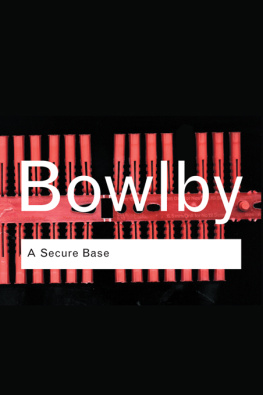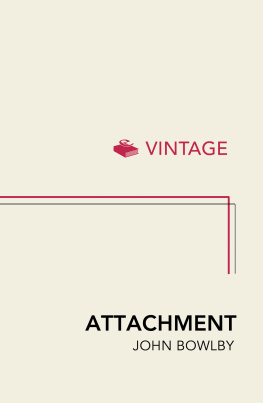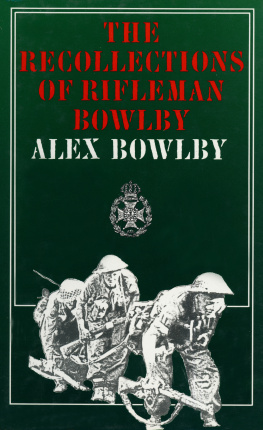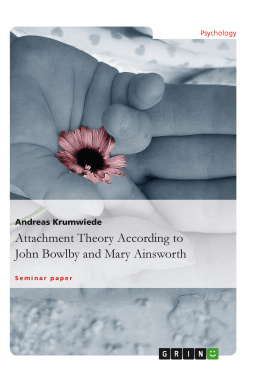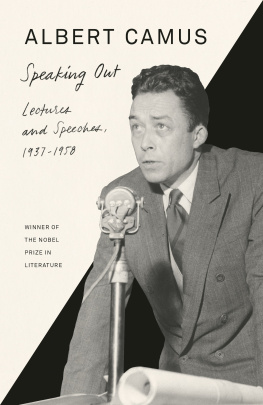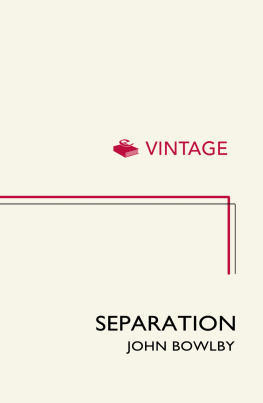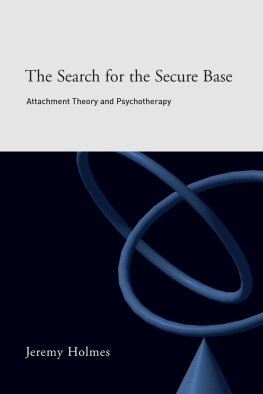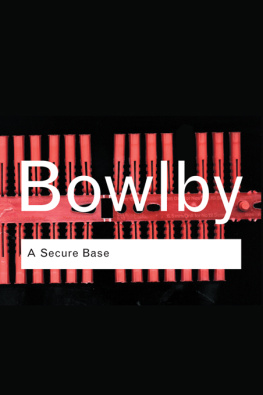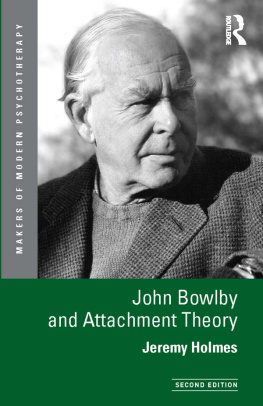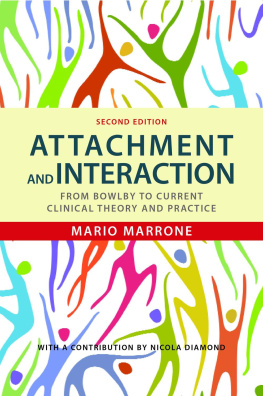Bowlby - A Secure Base
Here you can read online Bowlby - A Secure Base full text of the book (entire story) in english for free. Download pdf and epub, get meaning, cover and reviews about this ebook. publisher: Taylor and Francis, genre: Home and family. Description of the work, (preface) as well as reviews are available. Best literature library LitArk.com created for fans of good reading and offers a wide selection of genres:
Romance novel
Science fiction
Adventure
Detective
Science
History
Home and family
Prose
Art
Politics
Computer
Non-fiction
Religion
Business
Children
Humor
Choose a favorite category and find really read worthwhile books. Enjoy immersion in the world of imagination, feel the emotions of the characters or learn something new for yourself, make an fascinating discovery.
- Book:A Secure Base
- Author:
- Publisher:Taylor and Francis
- Genre:
- Rating:3 / 5
- Favourites:Add to favourites
- Your mark:
- 60
- 1
- 2
- 3
- 4
- 5
A Secure Base: summary, description and annotation
We offer to read an annotation, description, summary or preface (depends on what the author of the book "A Secure Base" wrote himself). If you haven't found the necessary information about the book — write in the comments, we will try to find it.
Bowlby: author's other books
Who wrote A Secure Base? Find out the surname, the name of the author of the book and a list of all author's works by series.
A Secure Base — read online for free the complete book (whole text) full work
Below is the text of the book, divided by pages. System saving the place of the last page read, allows you to conveniently read the book "A Secure Base" online for free, without having to search again every time where you left off. Put a bookmark, and you can go to the page where you finished reading at any time.
Font size:
Interval:
Bookmark:

A Secure Base
One of the most influential forces in child psychiatry and psychology, Dr. Bowlby challenged basic tenets of psychoanalysis and pioneered methods of investigating the emotional life of children.
The New York Times
John Bowlby was a towering figure in general psychiatry, child psychiatry and psychoanalysis. More than anyone else he demonstrated the importance of real-life childhood events for the development of later psychopathology.
The Independent

Routledge Classics contains the very best of Routledge publishing over the past century or so, books that have, by popular consent, become established as classics in their field. Drawing on a fantastic heritage of innovative writing published by Routledge and its associated imprints, this series makes available in attractive, affordable form some of the most important works of modern times.
For a complete list of titles visit
www.routledgeclassics.com
John
Bowlby
A Secure Base
Clinical Applications of Attachment Theory

First published 1988 by Routeldge
2 Park Square, Milton Park, Abingdon, Oxon, OX14 4RN
First published in Routledge Classics 2005
By Routledge
Simultaneously published in the USA and Canada
by Routledge
270 Madison Ave, New York, NY 10016
Routledge is an imprint of the Taylor & Francis Group
1988 R.P.L. Bowlby, R.J.M. Bowlby and A. Gaitling
Preface to Routledge Classics Edition 2005 Jeremy Holmes
Typeset in Joanna by RefineCatch Limited, Bungay, Suffolk
Printed and bound in Great Britain by
TJ International Ltd, Padstow, Cornwall
All rights reserved. No part of this book may be reprinted
or reproduced or utilized in any form or by any electronic,
mechanical, or other means, now known or hereafter
invented, including photocopying and recording, or in
any information storage or retrieval system, without
permission in writing from the publishers.
British Library Cataloguing in Publication Data
A catalogue record for this book is available from the British Library
Library of Congress Cataloging in Publication Data
A catalog record for this book has been requested
ISBN 0415355273
To
Mary D.S. Ainsworth
who introduced the concept of
a secure base
CONTENTS
PREFACE
In 1979, under the title of The Making and Breaking of Affectional Bonds, I published a small collection of lectures that I had given to a variety of audiences during the two preceding decades. In this volume I present a further selection of the lectures given since then. Each of the first five was delivered to a particular audience on a particular occasion; details of each are described in a brief preamble. The remaining three are extended versions of lectures given in extempore form to audiences made up of mental health professionals in countries of Europe and America. As in the earlier collection, I have thought it best to print each lecture in a form close to that in which it was originally published.
Since the theory of attachment provides the basis for every lecture some deletions have been necessary to avoid an excess of repetition. It is hoped that such as remains will, by presenting the same ideas in different contexts, clarify and emphasize distinctive features of the theory.
It is a little unexpected that, whereas attachment theory was formulated by a clinician for use in the diagnosis and treatment of emotionally disturbed patients and families, its usage hitherto has been mainly to promote research in developmental psychology. Whilst I welcome the findings of this research as enormously extending our understanding of personality development and psychopathology, and thus as of the greatest clinical relevance, it has none the less been disappointing that clinicians have been so slow to test the theorys uses. There are probably many reasons for this. One is that initially the data drawn on appeared to be unduly behavioural. Another is that clinicians are very busy people who are naturally reluctant to spend time trying to master a new and strange conceptual framework until they have strong reasons for believing that to do so will improve their clinical understanding and therapeutic skills. For those who have decided the time has come to sample what this new perspective has to offer I hope the lectures gathered here may provide a convenient introduction.
ACKNOWLEDGEMENTS
During the past ten years I have had the great benefit of frequent communication with staff and students at the Tavistock Clinic and also with a number of colleagues engaged in pioneering studies of how patterns of attachment develop during infancy and childhood. To all of them I owe a deep debt of gratitude, often for useful suggestions, sometimes for necessary corrections, and always for stimulation and encouragement. To my secretary, Dorothy Southern, I also owe a deep debt of gratitude for many years of devoted service during which she has made my interests her own.
For editorial assistance in preparing these lectures for publication and for constructing the index my thanks are due to Molly Townsend.
The first six lectures in this book have appeared in other publications and I am grateful to the publishers concerned for permission to reproduce them here. Lecture 1 was chapter 18 in Parenthood: A Psychodynamic Perspective edited by Rebecca S. Cohen, Bertram J. Cohler, and Sidney H. Weissman, the Guilford Press, New York (1984); Lecture 2 was Attachment and loss: retrospect and prospect, American Journal of Orthopsychiatry 52: 66478 (1982); Lecture 3 was Psychoanalysis as art and science, International Review of Psychoanalysis 6: 314 (1979); Lecture 4 was Psychoanalysis as a natural science, International Review of Psychoanalysis 8: 24356 (1981); Lecture 5 was Violence in the family as a disorder of the attachment and caregiving systems, The American Journal of Psychoanalysis 44: 927 (1984); Lecture 6 was chapter 6 in Cognition and Psychotherapy edited by Michael J. Mahoney and Arthur Freeman, Plenum Publishing Corporation, New York and London (1985), expanded from On knowing what you are not supposed to know and feeling what you are not supposed to feel, Canadian Journal of Psychiatry 24: 4038 (1979).
JOHN BOWLBY
PREFACE TO THE ROUTLEDGE CLASSICS EDITION
A Secure Base first appeared in 1988 when John Bowlby was in his 81st year. Although there was, amazingly, one more book to comethe Darwin biographyit is his final contribution to Attachment Theory, the discipline which he, with Mary Ainsworths help, founded nearly half a century earlier. Thus A Secure Base has a valedictory feel to ita summation of a lifes work, but also a tribute and a handing over to the next generation of attachment researchers and clinicians.
In it are to be found all the familiar Bowlbian themestheoretical, etiological, methodological, clinical, and political. He restates the conceptual foundation stones of his ideas: the primacy of the attachment behavioural response and its role in protection from predation; sensitive care-giving as a foundation for psychological health; the continuing importance of attachment throughout the life cycle. He argues powerfully for the role of real-life adversityemotional deprivation, un-mourned bereavement, rejection, obfuscation, neglect, physical and sexual abuseas the origin of subsequent psychopathology, as opposed to putative endo-psychic entities such as death instinct.
Next pageFont size:
Interval:
Bookmark:
Similar books «A Secure Base»
Look at similar books to A Secure Base. We have selected literature similar in name and meaning in the hope of providing readers with more options to find new, interesting, not yet read works.
Discussion, reviews of the book A Secure Base and just readers' own opinions. Leave your comments, write what you think about the work, its meaning or the main characters. Specify what exactly you liked and what you didn't like, and why you think so.

